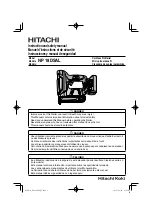
9
problems for these symptoms, trace the air supply from
the tool to the supply source for restrictive connectors,
low points containing water and anything else that would
SUHYHQWIXOOYROXPHÀRZRIDLUWRWKHWRRO
REQUIRED DAILY CHECKLIST
1. Disconnect the air supply from the tool and remove
all fasteners.
2. Check all screws, nuts, bolts, and pins on the tool. If
any of these are loose, they must be tightened with the
appropriate size wrench.
3. Press the safety yoke against a workpiece to ensure
that it moves smoothly.
4. With the safety yoke depressed, pull the trigger. The
trigger should move smoothly, without binding.
5. While the tool is not loaded, connect the appropriate
DLUVXSSO\DWEDUSVLWRWKHWRRO
Ɣ
Without pulling the trigger, press the safety yoke
against a workpiece several times. The tool must
not operate.
Ɣ
With the safety yoke not engaged on the workpiece,
point the tool down and away from you and other
persons, and pull the trigger several times. Hold
the trigger in this position for a minimum of 5
seconds. The tool must not operate.
Ɣ
Press the safety yoke firmly against the workpiece,
and pull the trigger. The tool must operate.
Ɣ
With the safety yoke still depressed, release the
trigger. The driver must return to its up position.
6. If the tool successfully meets all the requirements
in this checklist, it is ready for use. Load the proper
fasteners for the desired application.
7. Set the depth of drive according to the “drive depth
adjustment” section in this manual. Repeat this
checklist before using the tool each day, or if the tool is
dropped or damaged in any way.
WARNING
Do not use any attachments or accessories not
recommended by the manufacturer of this tool. The use
of attachments or accessories not recommended can
result in serious personal injury.
LUBRICATION
$Q
DXWRPDWLF
LQOLQH
¿OWHUUHJXODWRUOXEULFDWRU
LV
UHFRPPHQGHG)LJDVLWLQFUHDVHVSURGXFWOLIHDQGNHHSV
the product in sustained operation. The in-line lubricator
VKRXOGEHUHJXODUO\FKHFNHGDQG¿OOHGZLWKDLUWRRORLO
Proper adjustment of the in-line lubricator is performed by
placing a sheet of paper next to the exhaust ports and
actuate the tool 10 - 15 times without fasteners loaded.
The lubricator is properly set when a light stain of oil
collects on the paper. Excessive amounts of oil should be
avoided.
If it becomes necessary to store the product for an extended
SHULRGRIWLPHRYHUQLJKWZHHNHQGHWFLWVKRXOGUHFHLYH
a generous amount of lubrication at that time. Actuate the
tool 10 - 15 times without fasteners loaded to ensure oil
has been evenly distributed throughout the product. The
product should be stored in a clean and dry environment.
Ɣ
It is most important that the product be properly
lubricated by keeping the air line lubricator filled
and correctly adjusted. Without proper lubrication
the product will not work properly and parts will
wear prematurely.
Ɣ
Use correct lubricant in the air line lubricator. The
lubricator should be of low air flow or changing air
flow type, and should be kept filled to the correct
level. Use only recommended lubricants, specially
made for pneumatic applications. Substitutes
may harm the rubber compounds in the product's
O-rings and other rubber parts.
IMPORTANT!
6HH¿JXUH
,I D ¿OWHUUHJXODWRUOXEULFDWRU LV QRW LQVWDOOHG RQ WKH DLU
system, air operated tools should be lubricated at least
once a day or after 2 hours of work with 2 - 6 drops
of oil, depending on the work environment, directly
WKURXJKWKHPDOH¿WWLQJLQWKHWRROKRXVLQJ


































